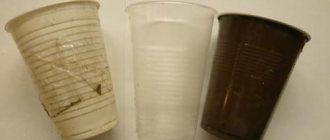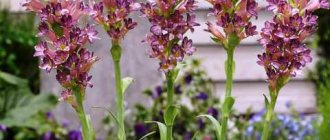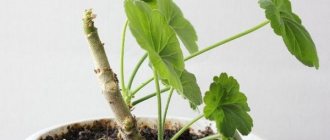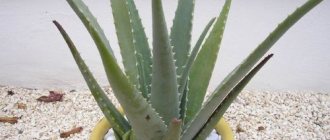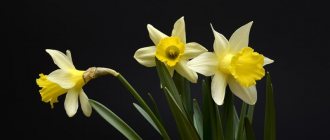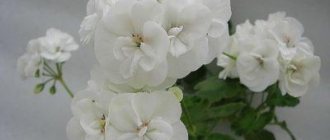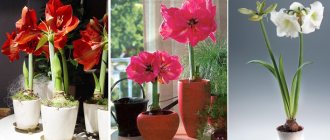We know geranium as an unpretentious indoor plant that delights with bright, numerous flowers from spring until winter. However, not everyone knows that there is another type of this flower that grows quietly in open ground. The hardy “sister” can be found in the garden, forest or marshy area. Botanists have divided them into two varieties, one of which is called “geranium” and the other “pelargonium”. It was the second that became the favorite of almost all gardeners. Both genera belong to the same Geranium family and have the same origin.
Features of winter and summer care for home geraniums
Geranium looks different in winter and summer. This is due to the length of the day and the need to give the plant a rest before the next flowering period.
In summer, protect pelargoniums from direct sunlight. In winter, choose the most illuminated window sill. If the apartment does not have south windows, use a phytolamp, extending the daylight hours to 12-14 hours. This way, the bush will retain its shape, the shoots will not lengthen, and the leaves will not fade.
The room temperature should be at least 22 degrees in summer and no more than 16 degrees in winter. Warmth will help pelargonium bloom magnificently in summer, and coolness in winter will allow you to get the necessary rest and gain strength.
By the way, pelargoniums tolerate ventilation well (not to be confused with drafts!), but not the dry heat of radiators.
In summer, during the flowering period, the plant should be watered more abundantly. In winter, when the geranium is dormant, watering should be moderate. This will prevent excessive soil moisture, which can cause root rot.
What to do with geraniums grown outside in autumn and winter?
Autumn can be very cold, especially in the pre-winter months, so don't risk leaving your geraniums outside. Plants can tolerate cold weather, but only to a certain extent. It is dangerous to expose pelargonium to night frosts and negative temperatures. It may freeze, which will lead to irreversible consequences.
In order to preserve the plants in time and lay the foundation for future flowering, they must be sent for the winter. To do this, you need to put the pelargonium on the balcony, porch, cellar, warm garage or basement. If it grows in a pot, there will be no problems with carrying it. And when grown in open ground, geranium must be carefully transplanted into a pot with a root ball and left for the winter in an unheated room.
Wintering geraniums
Geranium pruning
This procedure can be carried out in autumn or spring, depending on the variety of pelargonium. Zonal pelargoniums, for example, can grow greatly, and if this does not bother you in any way, they do not need to be pruned. In this case, small plants should be left without pruning until spring. For variegated varieties, pruning is very stressful, so it is recommended to do it in the spring. Ampelous pelargoniums need to be pruned only if they grow excessively.
Important: Always remove faded inflorescences and yellowed leaves, regardless of the type of geranium, and pruning is an individual procedure for almost each variety. For small pelargoniums, pruning will not matter much, but for large plants it is very important.
Procedure for pruning pelargoniums in autumn
At the end of September, cut off absolutely all flowering shoots, regardless of whether they have bloomed or are still active. This will help the geranium preserve its resources for the winter.
Leaves that have already turned yellow and wilted or are just beginning to turn yellow are removed. Experienced gardeners recommend pinching them off rather than cutting them with scissors. In the latter case, only a few protruding roots remain.
For denser flowering in September, pelargonium should be pruned before the branches begin or just above the node (from 3 to 5 cm). Then the top cut shoots can be rooted as cuttings. You need to continue pruning the plant until it loses its beautiful, lush appearance.
If the plant is young, it should only be pinched, and this must be done in accordance with the following rules :
- Start pinching young plants after they reach a height of 5-6 cm.
- When the geranium grows another 5 cm, it should be pinched again.
- To get a spherical bush, you can trim it three times in the same way.
Transplanting and feeding royal pelargonium
All types of pelargonium are characterized by the rapid growth of the above-ground part of the plant. If the roots of a bush that has grown considerably over the summer, taken out of the pot along with the soil, have completely entwined the earthen ball, at the end of winter the royal geranium is replanted. The soil for this crop should be loose, well-permeable and retain moisture. When wondering why royal pelargonium does not bloom, the gardener must also take into account the correct selection of soil mixture. A good option is a mixture of equal parts of disinfected garden soil, sand and peat.
Since the root system of the plant does not tolerate stagnant moisture, pelargonium requires a powerful drainage layer, and no less attention is paid to the selection of the pot when planting. It is because of transplantation into too large a container that many gardeners experience disappointment in the culture, and royal pelargonium does not bloom.
Once in a large pot, the plant rapidly increases its green mass, but completely “forgets” about the set of buds.
A similar process occurs with the wrong mixture of fertilizers. If nitrogen predominates in fertilizing during the formation of buds and flowering, the stems and leaves grow, and there are fewer and fewer buds. The best mixtures for feeding pelargonium are characterized by a high content of potassium and phosphorus, which ensures abundant and long-lasting flowering.
Let's summarize - the most important thing in caring for geraniums
Proper care is the key to growth and lush flowering. “Green friends” tolerate ventilation well, but cold drafts are dangerous for them. It is important to follow all recommendations during the first time after planting.
- The soil. To plant cuttings, use a mixture of sand and universal soil in a ratio of 1 to 2.
- A weak solution of potassium permanganate will disinfect the prepared soil from harmful microorganisms, parasites, and pests. Potassium permanganate solution can be replaced with boiling water. In this case, you must wait until the substrate cools down.
- If cuttings take root in water, you can add activated carbon to the water. This will reduce the chance of rotting.
- Lush bushes can be obtained by timely pruning. You can do this any time of the year.
- For the normal development of pelargonium in the room, it is necessary to maintain the temperature at +20 degrees Celsius.
- If the leaves begin to dry out during rooting, cover the container with the cuttings with polyethylene, film or a lid.
- It is more convenient to plant seedlings using plastic cups. A drainage layer must be laid at the bottom. In addition, drainage holes must be made.
- A lack of light will quickly lead to a loss of lushness, and the bushes will become stunted. The location of pelargonium should be reconsidered. In summer, pots or flowerpots should be placed on the balcony. Bright light gives the leaves a reddish tint, which is not a sign of disease, it's just a "tan."
- Watering should be moderate and systematic. Spraying is not necessary. The main rule is to not allow the soil to dry out. Signs of this are yellowing of the leaves and their falling off. Avoid stagnation of water (do not allow the root system and neck to rot). Good drainage can help with this. In winter, watering is carried out less frequently. It is enough to water pelargonium 2-3 times every 4 weeks.
- The following fertilizers are suitable for geranium: phosphorus, nitrogen, potassium. With the right ratio of elements, your green pet will bloom profusely. You can use special fertilizers and complexes for this type of flowering plants.
- Pruning is a prerequisite for the proper development of pelargonium. The best time for this procedure is autumn. It promotes the formation of an elegant crown and greater tillering.
Why doesn't royal pelargonium bloom?
Having planted a young plant in the ground, amateur gardeners look forward to the appearance of spectacular inflorescences above the greenery, but sometimes they have to face disappointment. Instead of flowers, large-flowered geranium produces only greenery, and the rapidly growing shoots soon lose their appearance and become elongated. What mistakes were made when caring for royal pelargonium at home, and why, as in the photo, was the plant left with almost no flowers?
Indeed, if pelargonium does not bloom in due time, this may indicate:
- about incorrectly selected temperature conditions or lack of lighting;
- that the plant is planted in a pot that is too large or receives fertilizers of an inharmonious composition;
- about untimely transplantation;
- about illiterate pruning or its complete absence.
How to care for royal pelargonium so that the plant blooms regularly, is healthy and does not lose its decorative appearance all year round?
Pelargonium cuttings
The resulting cuttings can be rooted all year round, but in the warm season it is much easier to do this.
As planting material, take strong shoot tips that have at least two pairs of leaves and are cut 5 mm below the node. It is better to cut off the lower leaves immediately and leave no more than 3 upper leaf plates. After this, the cut areas on the cuttings are treated with crushed charcoal and left in air for 18–24 hours.
True, there is another way. Already 10 minutes after separation from the mother plant, cut cuttings:
- treated with root;
- planted in a mixture of sand, humus and peat;
- Cover with non-woven material for 2–3 days.
Planting cuttings in moistened peat tablets gives good results.
In any case, the plantings are watered with a solution of phytosporin, which will protect the cuts from the development of rot. How to care for pelargonium after the cuttings have taken root?
It will take 8 to 12 weeks until the cuttings, kept at a temperature of 19–23 °C, take root well. After this time:
- young plants are planted in a permanent place;
- pinch the main shoot above the third pair of leaves, which will force the bush to produce new side stems.
If you care for royal pelargonium at home, as in the photo, well, the young plants develop well, and next spring small, neat bushes produce their first inflorescences.
2.Varieties:
2.1.Pelargonium rosebud
A distinctive feature of plants of this group are large, lush inflorescences consisting of double buds. Each flower has a large number of petals and its appearance resembles a miniature rose. In modern varieties, additional decoration of plants is also attractive round-shaped leaves, colored green with a burgundy circle on the surface or a bright white edge. Breeders also developed varieties whose buds are colored in 2 shades at once.
↑ Up,
2.2.Terry or peony geranium
Perennial flowering plants with large inflorescences consisting of double buds of white, pink or red. A characteristic feature of this group is a large number of petals, often tightly adjacent to each other. The buds sometimes remain half-open. The bushes are lush, stocky, reaching a height of 40 - 60 cm.
↑ Up,
2.3.Geranium Angel
This perennial is characterized by asymmetrical flowers with contrasting petals. Interestingly, the upper petals are often larger than the lower ones. Flowers are usually painted in 2 - 3 contrasting shades.
↑ Up,
2.4.Dwarf geranium
A characteristic feature of plants of this group is their compact size - often these perennials do not exceed 15 - 20 cm in height. Varieties belonging to this type are distinguished by abundant and long-lasting flowering and strong shape.
↑ Up,


